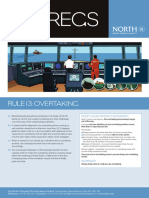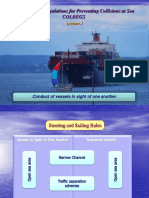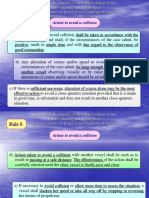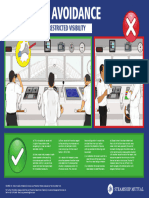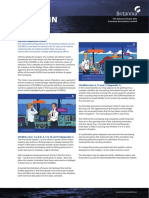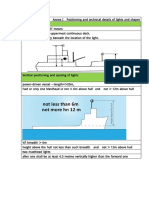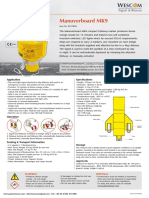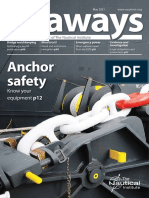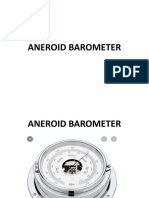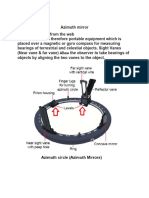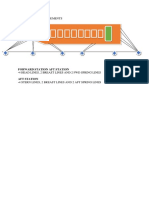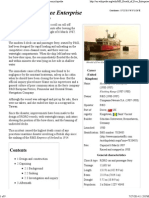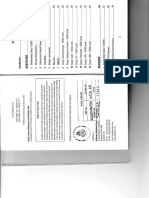Rule 17 Action by Stand On Vessel COLREGs Poster
Rule 17 Action by Stand On Vessel COLREGs Poster
Uploaded by
Ahsan IftikharCopyright:
Available Formats
Rule 17 Action by Stand On Vessel COLREGs Poster
Rule 17 Action by Stand On Vessel COLREGs Poster
Uploaded by
Ahsan IftikharOriginal Title
Copyright
Available Formats
Share this document
Did you find this document useful?
Is this content inappropriate?
Copyright:
Available Formats
Rule 17 Action by Stand On Vessel COLREGs Poster
Rule 17 Action by Stand On Vessel COLREGs Poster
Uploaded by
Ahsan IftikharCopyright:
Available Formats
COLREGs Rule 17
Action by
Stand-on Vessel
(a) (i) Where one of two vessels is to keep out of the way the other
shall keep her course and speed. Is It Giving Way?
(ii) The latter vessel may however take action to avoid collision by
-ON VESSEL
Rule 17 is one of the harder rules to understand and to follow. If you
her manoeuvre alone, as soon as it becomes apparent to her are the ‘stand-on vessel’ then you cannot relax.
that the vessel required to keep out of the way is not taking
Rule 17 has three stages and you must identify and assess each of
appropriate action in compliance with these Rules.
them:
(b) When, from any cause, the vessel required to keep her course and Rule 17(a)(i): when you are the ‘stand-on vessel’, you must keep
speed finds herself so close that collision cannot be avoided by the your course and speed. You must not do anything unexpected.
action of the give-way vessel alone, she shall take such action as will
best aid to avoid collision. Rule 17(a)(ii): ‘as soon as it becomes apparent’ that the give-way
vessel is not taking appropriate action, then you may take your
(c) A power-driven vessel which takes action in a crossing situation in own action to avoid a collision.
accordance with subparagraph (a)(ii) of this Rule to avoid collision with
Rule 17(b): when a collision cannot be avoided by the give-way
another power-driven vessel shall, if the circumstances of the case
vessel alone, then you must take the best action you can to avoid
admit, not alter course to port for a vessel on her own port side.
colliding. Your action under Rule 17(b) must still be in time to
(d) This Rule does not relieve the give-way vessel of her obligation to keep avoid a collision so you must not leave it too late.
out of the way.
But do not go to port in a crossing situation – if the other ship goes
to starboard, as it should, then both ships will turn towards each
other.
Do not forget the ‘wake up’ signal under Rule 34(d) on manoeuvring
and warning signals. Blow your horn and flash your lights at the other
vessel but think twice before calling it on VHF, because that always
takes valuable time during which the risk of collision will increase.
Summary
When approaching a give-way ship, maintain course and speed
but always be prepared to take action to avoid a collision.
For more information, please visit www.nepia.com
Copyright © 2019 The North of England P&I Association Limited
You might also like
- Property Law Notes KSLU Grand FinalDocument81 pagesProperty Law Notes KSLU Grand FinalKeshav Aggarwal100% (5)
- Herald of Free EnterpriseDocument9 pagesHerald of Free EnterprisePaul JamesonNo ratings yet
- M.V Estonia DisasterDocument4 pagesM.V Estonia DisasterhutsonianpNo ratings yet
- Benguet Electric Cooperative Inc. Vs FloresDocument1 pageBenguet Electric Cooperative Inc. Vs FloresNicole Marie Abella CortesNo ratings yet
- Colregs - Rule 19Document1 pageColregs - Rule 19VIVEK VPNo ratings yet
- Colregs Rule 14 Head On SituationDocument1 pageColregs Rule 14 Head On SituationAlex Moreno GarcíaNo ratings yet
- Colregs Rule 13 Overtaking - PDF 3Document1 pageColregs Rule 13 Overtaking - PDF 3jsanzone30311No ratings yet
- International Regulations For Preventing Collisions at Sea ColregsDocument12 pagesInternational Regulations For Preventing Collisions at Sea Colregsbloodyspark77100% (1)
- Colregs Rule 15 - Crossing SituationDocument1 pageColregs Rule 15 - Crossing SituationOlegNo ratings yet
- COLREGS Lecture 4Document26 pagesCOLREGS Lecture 4bloodyspark77100% (2)
- Colregs Rule 19 Restricted VisibilityDocument1 pageColregs Rule 19 Restricted VisibilitykumarNo ratings yet
- Collision Regulation Colregs Bulletin - 12-2013 PDFDocument2 pagesCollision Regulation Colregs Bulletin - 12-2013 PDFkahl983100% (1)
- Rule 13 Overtaking COLREGs PosterDocument1 pageRule 13 Overtaking COLREGs PosterVinoth KannaNo ratings yet
- Rule 8: Action To Avoid A CollisionDocument48 pagesRule 8: Action To Avoid A Collisionbloodyspark77100% (2)
- Unit 33 Collision Regulations (Colregs) Basic Terms: Rules Part A General 1 - 3 Part B Steering and Sailing RulesDocument34 pagesUnit 33 Collision Regulations (Colregs) Basic Terms: Rules Part A General 1 - 3 Part B Steering and Sailing RulesHassan SaidNo ratings yet
- Collision Conductof Vessel VisabityDocument1 pageCollision Conductof Vessel Visabityსერგო გურგენიძეNo ratings yet
- COLREGS Lecture 2Document23 pagesCOLREGS Lecture 2bloodyspark77100% (1)
- Herald of Free EnterpriseDocument5 pagesHerald of Free Enterpriseexcelle reyesNo ratings yet
- Alert Effective CommunicationDocument1 pageAlert Effective CommunicationPetar SaydenovNo ratings yet
- MS Herald of Free EnterpriseDocument7 pagesMS Herald of Free EnterpriseJOSHUA GUIMBANGUNANNo ratings yet
- Ship Stabilty Stabilitas KapalDocument75 pagesShip Stabilty Stabilitas KapalJony Rabuansyah100% (1)
- COLREGs 08 2013Document4 pagesCOLREGs 08 2013iwanNo ratings yet
- Adreno BarometerDocument12 pagesAdreno BarometerShailendra VishwakarmaNo ratings yet
- PSC & RB Revalidation Course (Seafarer Deck) : Following Slides Will Show You What To Do at BMTC Training Centre in MMUDocument13 pagesPSC & RB Revalidation Course (Seafarer Deck) : Following Slides Will Show You What To Do at BMTC Training Centre in MMUSun Htoo MyintNo ratings yet
- Collision Conduct OvertakingDocument1 pageCollision Conduct OvertakinghogaleNo ratings yet
- 5.short Cut AnnexDocument15 pages5.short Cut AnnexAbu Syeed Md. Aurangzeb Al MasumNo ratings yet
- Herald of Free Enterprise Ferry Essay - HenryDocument3 pagesHerald of Free Enterprise Ferry Essay - HenryNelly PrincessNo ratings yet
- Colregs Rule 15 Crossing SituationDocument1 pageColregs Rule 15 Crossing SituationCSB100% (1)
- The Automatic PilotDocument10 pagesThe Automatic PilotringboltNo ratings yet
- Disposable H.R.U (2 Years) Serviceable H.R.U (1 Year)Document19 pagesDisposable H.R.U (2 Years) Serviceable H.R.U (1 Year)Sun Htoo MyintNo ratings yet
- Colregs Rule 19 - Restricted VisibilityDocument1 pageColregs Rule 19 - Restricted VisibilityOlegNo ratings yet
- Nav04 - Pilot Card: The Officer Completing The Checklist MUST Enter His Initials As ConfirmationDocument4 pagesNav04 - Pilot Card: The Officer Completing The Checklist MUST Enter His Initials As ConfirmationКонстантин КулаковNo ratings yet
- PainsWessex MK9 MOB ManualDocument1 pagePainsWessex MK9 MOB ManualVishal ShawNo ratings yet
- Traffic Separation Schemes: Colregs Rule 10Document1 pageTraffic Separation Schemes: Colregs Rule 10Paschos Dimitrios100% (1)
- Basic Radar Plot: Craig LeppertDocument25 pagesBasic Radar Plot: Craig LeppertJeet SinghNo ratings yet
- 2021 05 01 - SeawaysDocument40 pages2021 05 01 - SeawaysMuhammad100% (1)
- Aneroid BarometerDocument23 pagesAneroid BarometerParminder singh parmarNo ratings yet
- IALADocument2 pagesIALASergo Malakmadze100% (1)
- Azimuth PointDocument13 pagesAzimuth PointChriss Jobin100% (1)
- On-Load & Off-LoadDocument23 pagesOn-Load & Off-LoadSun Htoo Myint100% (1)
- Lesson 4.1 Introduction To Stability: BM KMDocument66 pagesLesson 4.1 Introduction To Stability: BM KMDrago Dragic100% (1)
- ARAMCO - Examination Updated (Recovered)Document43 pagesARAMCO - Examination Updated (Recovered)diditNo ratings yet
- 7 Points For Safe Ship Mooring Operations-1Document9 pages7 Points For Safe Ship Mooring Operations-1Francisco LagoNo ratings yet
- RONDocument7 pagesRONRonnel Ganuelas100% (1)
- MS Herald of Free Enterprise - Wikipedia, The Free EncyclopediaDocument9 pagesMS Herald of Free Enterprise - Wikipedia, The Free EncyclopediabmxengineeringNo ratings yet
- 4 Loadline PDFDocument26 pages4 Loadline PDFASWIN KRISHNA PRNo ratings yet
- Colreg-06 Safe SpeedDocument1 pageColreg-06 Safe SpeedAhmad RamdhanNo ratings yet
- Bridge Watchkeeping Ship Handling and Emergencies Hand Written Notes by Kevin KolacoDocument94 pagesBridge Watchkeeping Ship Handling and Emergencies Hand Written Notes by Kevin KolacoAnkit MauryaNo ratings yet
- Traffic Separation SchemesDocument1 pageTraffic Separation SchemesStevenDouglas100% (2)
- Light and Smoke Signal: Warning DisposalDocument1 pageLight and Smoke Signal: Warning Disposalariesyiha100% (1)
- Setting Up An ARPADocument1 pageSetting Up An ARPAAbass Gurua100% (1)
- Colregs Rule 02 ResponsibilityDocument1 pageColregs Rule 02 ResponsibilitykumarNo ratings yet
- 2R SquatDocument11 pages2R SquatInsan Ahammad100% (1)
- Colregs Part F New RulesDocument3 pagesColregs Part F New RulesRakesh Pandey100% (1)
- 3b Midterm LMS SEAM 6Document90 pages3b Midterm LMS SEAM 6Patrick CastroNo ratings yet
- Colregs Symbols PDFDocument2 pagesColregs Symbols PDFIbraaheem RafeeuNo ratings yet
- Why Do Boats Float and Rocks Sink?Document4 pagesWhy Do Boats Float and Rocks Sink?KlolofillNo ratings yet
- 13 Timber Deck Cargoes (II)Document24 pages13 Timber Deck Cargoes (II)Kyaw Zin LynnNo ratings yet
- Macneils Oow Pocket BookDocument79 pagesMacneils Oow Pocket BooknarenNo ratings yet
- Colreg 05 LookoutDocument1 pageColreg 05 LookoutAhmad RamdhanNo ratings yet
- App 5 - Diving ChecklistDocument1 pageApp 5 - Diving Checklisthsse.maltaNo ratings yet
- Colregs Rule 17 Action by Stand On Vessel PDFDocument1 pageColregs Rule 17 Action by Stand On Vessel PDFshabrinaNo ratings yet
- All About Cruise Industry PDFDocument16 pagesAll About Cruise Industry PDFKiara ClirwinNo ratings yet
- SRSA Timeline PDFDocument1 pageSRSA Timeline PDFcool guy reallyNo ratings yet
- Service Bulletin: AB Volvo PentaDocument3 pagesService Bulletin: AB Volvo PentaAnees AhmedNo ratings yet
- Mpi Report of Cawthorn 3 Platform Section 12bDocument1 pageMpi Report of Cawthorn 3 Platform Section 12bGodwin UdoakanNo ratings yet
- Cooking Verbs Vocabulary Missing Letters in Words Esl WorksheetDocument2 pagesCooking Verbs Vocabulary Missing Letters in Words Esl WorksheetMariagabriela ArgüelloNo ratings yet
- Defendant's Notice of Filing Extradition Petition For Habeas CorpusDocument257 pagesDefendant's Notice of Filing Extradition Petition For Habeas CorpusNeil GillespieNo ratings yet
- MACFSY Digital PacketDocument22 pagesMACFSY Digital PacketfairsentenceNo ratings yet
- IsroDocument6 pagesIsroesk1234No ratings yet
- Santos vs. SantosDocument2 pagesSantos vs. Santosjulandmic9100% (6)
- Two Ways To Live: Revelation 4:11 Romans 3:10-12 Hebrews 9:27Document3 pagesTwo Ways To Live: Revelation 4:11 Romans 3:10-12 Hebrews 9:27Audgan97No ratings yet
- Department of Justice - James M. Bradley JR. SA Complaint Alien SmugglingDocument2 pagesDepartment of Justice - James M. Bradley JR. SA Complaint Alien SmugglingAdrian GarciaNo ratings yet
- PetitionDocument3 pagesPetitionPlo sigeiNo ratings yet
- RM Term Paper Am1212, Am2512Document20 pagesRM Term Paper Am1212, Am2512Neel PatelNo ratings yet
- GetrnoprintDocument1 pageGetrnoprintRitik GujjarNo ratings yet
- Zomato - Vendor Code of ConductDocument4 pagesZomato - Vendor Code of ConductpavanNo ratings yet
- Maanshan Iron & Steel Co., LTD - EXP 26.09.2025Document4 pagesMaanshan Iron & Steel Co., LTD - EXP 26.09.2025Esvimy Deliquena CauilanNo ratings yet
- Sales - J. Sanchez - Finals ReviewerDocument33 pagesSales - J. Sanchez - Finals ReviewerTina Reyes-BattadNo ratings yet
- The Tannaim by John U. RikkaDocument3 pagesThe Tannaim by John U. Rikkajohn umaru rikkaNo ratings yet
- Module 12Document20 pagesModule 12monkeybonz92No ratings yet
- Nitish Kumar Agarwalka03af2392Document3 pagesNitish Kumar Agarwalka03af2392Parotta SooriNo ratings yet
- Buoyant Factsheet - April 2024Document13 pagesBuoyant Factsheet - April 2024coinage capitalNo ratings yet
- Security Economics Knowledge GuideDocument25 pagesSecurity Economics Knowledge GuideTeo Liang WeiNo ratings yet
- Discovery Kit For STM32F100 Value LineDocument4 pagesDiscovery Kit For STM32F100 Value LineAli BarakatNo ratings yet
- US Vs .Gregory CraigDocument24 pagesUS Vs .Gregory CraigWashington ExaminerNo ratings yet
- FAQ List For VOLKSWAGEN CATIA Additional ApplicationsDocument37 pagesFAQ List For VOLKSWAGEN CATIA Additional ApplicationszarasettNo ratings yet
- English Translation of Magna Carta - The British LibraryDocument8 pagesEnglish Translation of Magna Carta - The British LibraryluisinaNo ratings yet
- The Development of Criminal LawDocument17 pagesThe Development of Criminal LawHarsh DixitNo ratings yet
- Micro, Small, and Medium Enterprises: A Collection of Published DataDocument10 pagesMicro, Small, and Medium Enterprises: A Collection of Published Datamorrisonkaniu8283No ratings yet






